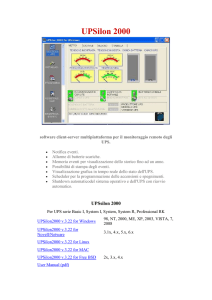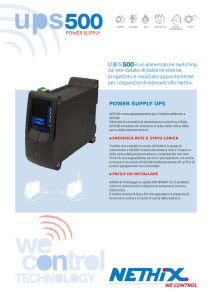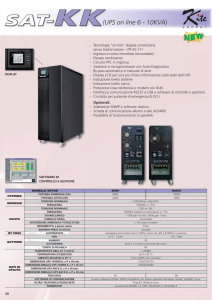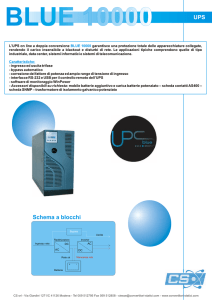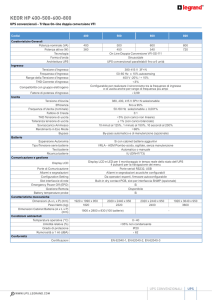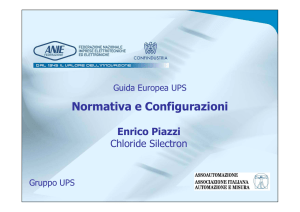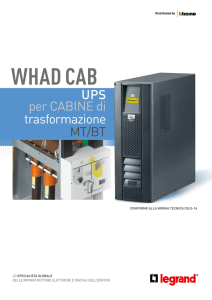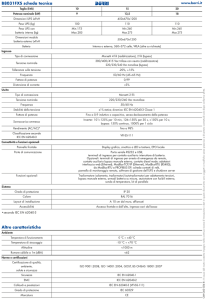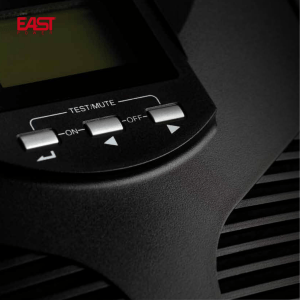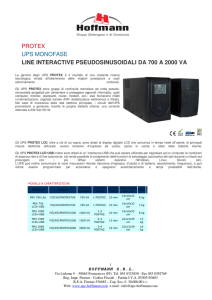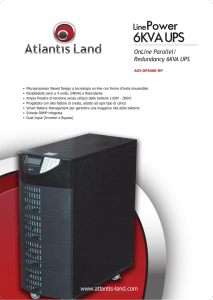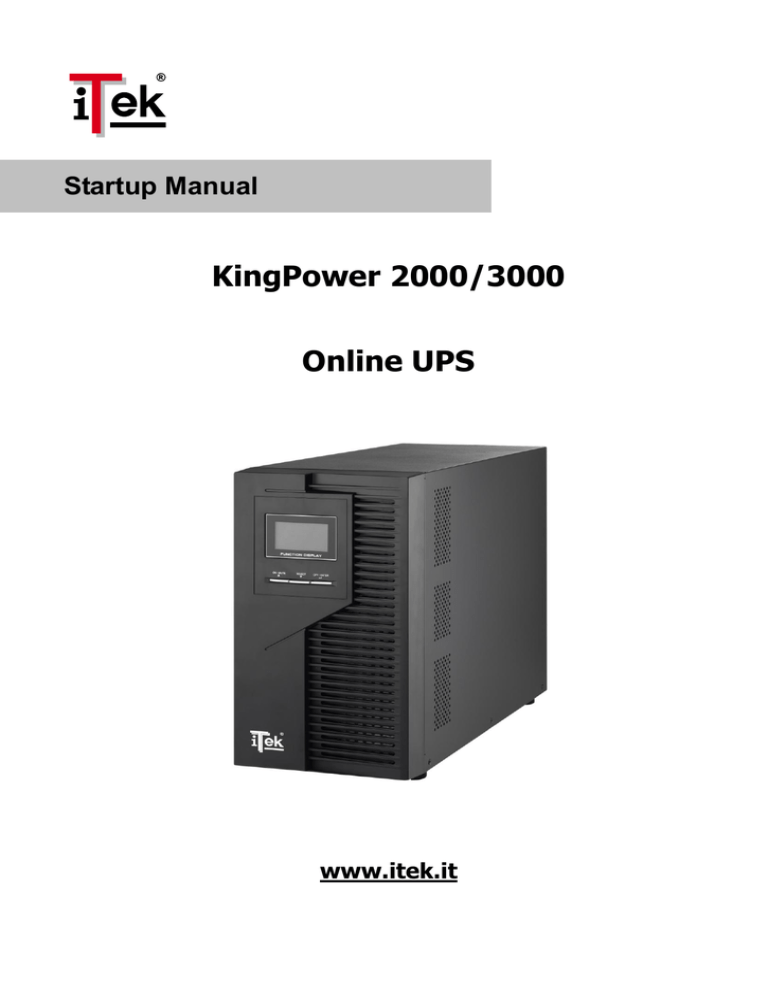
Startup Manual
KingPower 2000/3000
Online UPS
www.itek.it
Table of Contents
EN
1. Important Safety Warning ................................................................................... 2
1-1. Transportation .................................................................................................... 2
1-2. Preparation ........................................................................................................ 2
1-3. Installation ......................................................................................................... 2
1-4. Operation ........................................................................................................... 2
1-5. Maintenance, service and faults ........................................................................... 3
2. Installation and setup .......................................................................................... 4
2-1. Rear panel view.................................................................................................. 4
2-2. Setup the UPS .................................................................................................... 5
3. Operations ............................................................................................................ 7
3-1. Button operation ................................................................................................ 7
3-2. LCD Panel .......................................................................................................... 7
3-3. Audible Alarm ..................................................................................................... 9
3-4. LCD display wordings index ................................................................................. 9
3-5. UPS Setting ........................................................................................................ 9
3-6. Operating Mode Description .............................................................................. 13
3-7. Faults Reference Code....................................................................................... 13
3-8. Warning indicator ............................................................................................. 14
4. Troubleshooting.................................................................................................. 15
5. Storage and Maintenance ................................................................................... 17
6. Specifications ..................................................................................................... 18
1
EN
1. Important Safety Warning
Please comply with all warnings and operating instructions in this manual strictly. Save this
manual properly and read carefully the following instructions before installing the unit. Do not
operate this unit before reading through all safety information and operating instructions
carefully
1-1. Transportation
Please transport the UPS system only in the original package to protect against shock
and impact.
1-2. Preparation
Condensation may occur if the UPS system is moved directly from cold to warm
environment. The UPS system must be absolutely dry before being installed. Please
allow at least two hours for the UPS system to acclimate the environment.
Do not install the UPS system near water or in moist environments.
Do not install the UPS system where it would be exposed to direct sunlight or near
heater.
Do not block ventilation holes in the UPS housing.
1-3. Installation
Do not connect appliances or devices which would overload the UPS system (e.g.
laser printers) to the UPS output sockets.
Place cables in such a way that no one can step on or trip over them.
Do not connect domestic appliances such as hair dryers to UPS output sockets.
The UPS can be operated by any individuals with no previous experience.
Connect the UPS system only to an earthed shockproof outlet which must be easily
accessible and close to the UPS system.
Please use only VDE-tested, CE-marked mains cable (e.g. the mains cable of your
computer) to connect the UPS system to the building wiring outlet (shockproof
outlet).
Please use only VDE-tested, CE-marked power cables to connect the loads to the UPS
system.
When installing the equipment, it should ensure that the sum of the leakage current
of the UPS and the connected devices does not exceed 3.5mA.
1-4. Operation
Do not disconnect the mains cable on the UPS system or the building wiring outlet
(shockproof socket outlet) during operations since this would cancel the protective
earthing of the UPS system and of all connected loads.
The UPS system features its own, internal current source (batteries). The UPS output
sockets or output terminals block may be electrically live even if the UPS system is not
connected to the building wiring outlet.
In order to fully disconnect the UPS system, first press the OFF/Enter button to
disconnect the mains.
Prevent no fluids or other foreign objects from inside of the UPS system.
2
1-5. Maintenance, service and faults
The UPS system operates with hazardous voltages. Repairs may be carried out only
by qualified maintenance personnel.
Caution - risk of electric shock. Even after the unit is disconnected from the mains
(building wiring outlet), components inside the UPS system are still connected to the
battery and electrically live and dangerous.
Before carrying out any kind of service and/or maintenance, disconnect the batteries
and verify that no current is present and no hazardous voltage exists in the terminals
of high capability capacitor such as BUS-capacitors.
Only persons are adequately familiar with batteries and with the required
precautionary measures may replace batteries and supervise operations.
Unauthorized persons must be kept well away from the batteries.
Caution - risk of electric shock. The battery circuit is not isolated from the input
voltage. Hazardous voltages may occur between the battery terminals and the
ground. Before touching, please verify that no voltage is present!
Batteries may cause electric shock and have a high short-circuit current. Please take
the precautionary measures specified below and any other measures necessary when
working with batteries:
-remove wristwatches, rings and other metal objects
-use only tools with insulated grips and handles.
When changing batteries, install the same number and same type of batteries.
Do not attempt to dispose of batteries by burning them. This could cause battery
explosion.
Do not open or destroy batteries. Escaping electrolyte can cause injury to the skin
and eyes. It may be toxic.
Please replace the fuse only with the same type and amperage in order to avoid fire
hazards.
Do not dismantle the UPS system.
3
EN
EN
2. Installation and setup
NOTE: Before installation, please inspect the unit. Be sure that nothing inside the package is
damaged. Please keep the original package in a safe place for future use.
NOTE: There are two different types of online UPS: standard and long-run models. Please
refer to the following model table.
Model
KingPower 2K
KingPower 3K
Type
Model
KingPower 2KL
KingPower 3KL
Standard
2-1. Rear panel view
KingPower 2K(L)
KingPower 3K(L)
1. Programmable outlets: connect to non-critical loads.
2. Output receptacles: connect to mission-critical loads.
3. AC input
4. Input circuit breaker
5. Network/Fax/Modem surge protection
6. Emergency power off function connector (EPO)
7. USB communication port
8. RS-232 communication port
9. SNMP intelligent slot
10. External battery connection (only available for L model)
11. Output terminal
4
Type
Long-run
2-2. Setup the UPS
Step 1: UPS input connection
Plug the UPS into a two-pole, three-wire, grounded receptacle only. Avoid using extension
cords.
For 200/208/220/230/240VAC models: The power cord is supplied in the UPS package.
For 100/110/115/120/127VAC models: The power cord is attached to the UPS. The input
plug is a NEMA 5-20P for 2K and 2KL models.
Note: For Low voltage models: Check if the site wiring fault indicator lights up in LCD panel. It
will be illuminated when the UPS is plugged into an improperly wired utility power outlet (Refer
to Troubleshooting section). Please also install a circuit breaker (40A) between the mains and
AC input in 3K model for safety operation.
Step 2: UPS output connection
For socket-type outputs, there two kinds of outputs: programmable outlets and general
outlets. Please connect non-critical devices to the programmable outlets and critical
devices to the general outlets. During power failure, you may extend the backup time to
critical devices by setting shorter backup time for non-critical devices.
For terminal-type input or outputs, please follow below steps for the wiring configuration:
a) Remove the small cover of the terminal block
b) Suggest using AWG14 or 2.1mm2 power cords. Suggest using AWG12-10 or
3.3mm2-5.3mm2 power cords for NEMA type.
c) Upon completion of the wiring configuration, please check whether the wires are
securely affixed.
d) Put the small cover back to the rear panel.
Step 3: Communication connection
Communication port:
USB port
RS-232 port
Intelligent slot
To allow for unattended UPS shutdown/start-up and status monitoring, connect the
communication cable one end to the USB/RS-232 port and the other to the communication
port of your PC. With the monitoring software installed, you can schedule UPS
shutdown/start-up and monitor UPS status through PC.
The UPS is equipped with intelligent slot perfect for either SNMP or AS400 card. When
installing either SNMP or AS400 card in the UPS, it will provide advanced communication and
monitoring options.
PS. USB port and RS-232 port can’t work at the same time.
Step 4: Network connection
Network/Fax/Phone surge port
Connect a single modem/phone/fax line into surge-protected “IN” outlet on the back panel of
the UPS unit. Connect from “OUT” outlet to the equipment with another modem/fax/phone line
cable.
5
EN
EN
Step 5: Disable and enable EPO function
Keep the pin 1 and pin 2 closed for UPS normal operation. To activate EPO function, cut the
wire between pin 1 and pin 2.
It’s in closed status for UPS
normal operation.
Step 6: Turn on the UPS
Press the ON/Mute button on the front panel for two seconds to power on the UPS.
Note: The battery charges fully during the first five hours of normal operation. Do not
expect full battery run capability during this initial charge period.
Step 7: Install software
For optimal computer system protection, install UPS monitoring software to fully configure UPS
shutdown. You may insert provided CD into CD-ROM to install the monitoring software. If not,
please follow steps below to download and install monitoring software from the internet:
1. Go to the website http://www.power-software-download.com
2. Click ViewPower software icon and then choose your required OS to download the software.
3. Follow the on-screen instructions to install the software.
4. When your computer restarts, the monitoring software will appear as an orange plug icon
located in the system tray, near the clock.
Step 8: External battery connection (for long-run models only)
Follow the right chart to make external
battery connection.
6
EN
3. Operations
3-1. Button operation
Button
Function
Turn on the UPS: Press and hold ON/Mute button for at least 2
seconds to turn on the UPS.
Mute the alarm: When the UPS is on battery mode, press and hold
this button for at least 5 seconds to disable or enable the alarm
system. But it’s not applied to the situations when warnings or errors
ON/Mute Button
occur.
Up key: Press this button to display previous selection in UPS setting
mode.
Switch to UPS self-test mode: Press and hold ON/Mute button for 5
seconds to enter UPS self-testing while in AC mode, ECO mode, or
converter mode.
Turn off the UPS: Press and hold this button at least 2 seconds to turn
off the UPS. UPS will be in standby mode under power normal or
transfer to Bypass mode if the Bypass enable setting by pressing this
OFF/Enter Button
button.
Confirm selection key: Press this button to confirm selection in UPS
setting mode.
Switch LCD message: Press this button to change the LCD message
for input voltage, input frequency, battery voltage, output voltage
and output frequency. It will return back to default display when
pausing for 10 seconds.
Select Button
Setting mode: Press and hold this button for 5 seconds to enter UPS
setting mode when UPS is in standby mode or bypass mode.
Down key: Press this button to display next selection in UPS setting
mode.
Switch to bypass mode: When the main power is normal, press
ON/Mute + Select
ON/Mute and Select buttons simultaneously for 5 seconds. Then UPS
Button
will enter to bypass mode. This action will be ineffective when the
input voltage is out of acceptable range.
3-2. LCD Panel
7
EN
Display
Function
Remaining backup time information
Indicates the remaining backup time in pie chart.
Indicates the remaining backup time in numbers.
H: hours, M: minute, S: second
Fault information
Indicates that the warning and fault occurs.
Indicates the warning and fault codes, and the codes are listed in
details in 3-5 section.
Mute operation
Indicates that the UPS alarm is disabled.
Output & Battery voltage information
Indicates the output voltage, frequency or battery voltage.
Vac: output voltage, Vdc: battery voltage, Hz: frequency
Load information
Indicates the load level by 0-25%, 26-50%, 51-75%, and
76-100%.
Indicates overload.
Indicates the load or the UPS output is short circuit.
Programmable outlets information
Indicates that programmable management outlets are working.
Mode operation information
Indicates the UPS connects to the mains.
Indicates the battery is working.
Indicates the bypass circuit is working.
Indicates the ECO mode is enabled.
Indicates the Inverter circuit is working.
Indicates the output is working.
Battery information
Indicates the Battery level by 0-25%, 26-50%, 51-75%, and
76-100%.
Indicates the battery is fault.
Indicates low battery level and low battery voltage.
Input & Battery voltage information
8
Indicates the input voltage or frequency or battery voltage.
Vac: Input voltage, Vdc: battery voltage, Hz: input frequency
3-3. Audible Alarm
Battery Mode
Sounding every 4 seconds
Low Battery
Sounding every second
Overload
Sounding twice every second
Fault
Continuously sounding
Bypass Mode
Sounding every 10 seconds
3-4. LCD display wordings index
Abbreviation
Display content
Meaning
ENA
Enable
DIS
Disable
ESC
Escape
HLS
High loss
LLS
Low loss
BAT
Battery
CF
Converter
EP
EPO
TP
Temperature
CH
Charger
FU
Bypass frequency unstable
EE
EEPROM error
3-5. UPS Setting
There are three parameters to set up the
UPS.
Parameter 1
Parameter 1: It’s for program
alternatives. There are 10 programs to set
up. Refer to below table.
Parameter 2 and parameter 3 are the
setting options or values for each
program.
Parameter 2
Parameter 3
9
EN
EN
01: Output voltage setting
Interface
Setting
Parameter 3: Output voltage
For 200/208/220/230/240 VAC models, you may choose
the following output voltage:
200: presents output voltage is 200Vac
208: presents output voltage is 208Vac
220: presents output voltage is 220Vac
230: presents output voltage is 230Vac (Default)
240: presents output voltage is 240Vac
For 100/110/150/120/127 VAC models, you may choose
the following output voltage:
100: presents output voltage is 100Vac
110: presents output voltage is 110Vac
115: presents output voltage is 115Vac
120: presents output voltage is 120Vac (Default)
127: presents output voltage is 127Vac
02: Frequency Converter enable/disable
Interface
Setting
Parameter 2 & 3: Enable or disable converter mode. You
may choose the following two options:
CF ENA: converter mode enable
CF DIS: converter mode disable (Default)
03: Output frequency setting
Interface
Setting
Parameter 2 & 3: Output frequency setting.
You may set the initial frequency on battery mode:
BAT 50: presents output frequency is 50Hz
BAT 60: presents output frequency is 60Hz
If converter mode is enabled, you may choose the
following output frequency:
CF 50: presents output frequency is 50Hz
CF 60: presents output frequency is 60Hz
04: ECO enable/disable
Interface
Setting
Parameter 3: Enable or disable ECO function. You may
choose the following two options:
ENA: ECO mode enable
DIS: ECO mode disable (Default)
10
05: ECO voltage range setting
Interface
Setting
Parameter 2 & 3: Set the acceptable high voltage point
and low voltage point for ECO mode by pressing Down key
or Up key.
HLS: High loss voltage in ECO mode in parameter 2.
For 200/208/220/230/240 VAC models, the setting range
in parameter 3 is from +7V to +24V of the nominal voltage.
(Default: +12V)
For 100/110/115/120/127 VAC models, the setting range
in parameter 3 is from +3V to +12V of the nominal voltage.
(Default: +6V)
LLS: Low loss voltage in ECO mode in parameter 2.
For 200/208/220/230/240 VAC models, the setting range
in parameter 3 is from -7V to -24V of the nominal voltage.
(Default: -12V)
For 100/110/115/120/127 VAC models, the setting voltage
in parameter 3 is from -3V to -12V of the nominal voltage.
(Default: -6V)
06: Bypass enable/disable when UPS is off
Interface
Setting
Parameter 3: Enable or disable Bypass function. You may
choose the following two options:
ENA: Bypass enable
DIS: Bypass disable (Default)
07: Bypass voltage range setting
Interface
Setting
Parameter 2 & 3: Set the acceptable high voltage point
and acceptable low voltage point for Bypass mode by
pressing the Down key or Up key.
HLS: Bypass high voltage point
For 200/208/220/230/240 VAC models:
230-264: setting the high voltage point in parameter 3
from 230Vac to 264Vac. (Default: 264Vac)
For 100/110/115/120/127 VAC models:
120-140: setting the high voltage point in parameter 3
from 120Vac to 140Vac(Default: 132Vac)
LLS: Bypass low voltage point
For 200/208/220/230/240 VAC models:
170-220: setting the low voltage point in parameter 3
from 170Vac to 220Vac (Default: 170Vac)
For 100/110/115/120/127 VAC models:
85-115: setting the low voltage point in parameter 3 from
85Vac to 115Vac. (Default: 85Vac)
11
EN
EN
08: Programmable outlets enable/disable
Interface
Setting
Parameter 3: Enable or disable programmable outlets.
ENA: Programmable outlets enable
DIS: Programmable outlets disable (Default)
09: Programmable outlets setting
Interface
Setting
Parameter 3: Set up backup time limits for
programmable outlets.
0-999: setting the backup time limits in minutes from
0-999 for programmable outlets which connect to
non-critical devices on battery mode. (Default: 999)
10: Autonomy limitation setting
Interface
Setting
Parameter 3: Set up backup time on battery mode for
general outlets.
0-999: setting the backup time in minutes from 0-999
for general outlets on battery mode.
0: When setting as “0”, the backup time will be only 10
seconds.
999: When setting as “999”, the backup time setting will
be disabled. (Default)
00: Exit setting
12
3-6. Operating Mode Description
Operating mode Description
LCD display
Online mode
When the input voltage is within
acceptable range, UPS will provide pure
and stable AC power to output. The UPS
will also charge the battery at online
mode.
ECO mode
Energy saving mode:
When the input voltage is within voltage
regulation range, UPS will bypass
voltage to output for energy saving.
Frequency
Converter mode
When input frequency is within 40 Hz to
70 Hz, the UPS can be set at a constant
output frequency, 50 Hz or 60 Hz. The
UPS will still charge battery under this
mode.
Battery mode
When the input voltage is beyond the
acceptable range or power failure and
alarm is sounding every 4 second, UPS
will backup power from battery.
Bypass mode
When input voltage is within acceptable
range but UPS is overload, UPS will enter
bypass mode or bypass mode can be set
by front panel. Alarm is sounding every
10 second.
Standby mode
UPS is powered off and no output supply
power, but still can charge batteries.
3-7. Faults Reference Code
Fault event
Fault code
Bus start fail
01
Bus over
02
Bus under
03
Bus unbalance
04
Bus fault
05
Inverter soft start fail
11
Inverter voltage high
12
Icon
x
x
x
x
x
x
x
Fault event
Inverter voltage Low
Inverter output short
Battery voltage too high
Battery voltage too low
Over temperature
Over load
13
EN
Fault code
13
14
27
28
41
43
Icon
x
x
EN
3-8. Warning indicator
Warning
Icon (flashing)
Alarm
Low Battery
Sounding every second
Overload
Sounding twice every second
Battery is not connected
Sounding every second
Sounding every second
Over Charge
Sounding every second
Site wiring fault
EPO enable
Sounding every second
Over temperature
Sounding every second
Charger failure
Sounding every second
Battery fault
Sounding every second
Out of bypass voltage range
Sounding every second
Bypass frequency unstable
Sounding every second
EEPROM error
Sounding every second
NOTE: “Site Wiring Fault” function can be enabled/disabled via software. Please check
software manual for the details.
14
EN
4. Troubleshooting
If the UPS system does not operate correctly, please solve the problem by using the table
below.
Symptom
Possible cause
Remedy
No indication and alarm even
The AC input power is not Check if input power cord
though the mains is normal.
connected well.
firmly connected to the
mains.
The AC input is connected Plug AC input power cord
to the UPS output.
to AC input correctly.
The icon
and the warning
code
flashing on LCD
display and alarm is sounding
every second.
EPO function is activated.
Set the circuit in closed
position to disable EPO
function.
Line and neutral
The icon
and
flashing on conductors of UPS input
LCD display and alarm is sounding are reversed.
every second.
The external or internal
The icon
and
flashing
battery is incorrectly
on LCD display and alarm is
connected.
sounding every second.
Rotate mains power socket
by 180° and then connect
to UPS system.
Fault code is shown as 27 and the Battery voltage is too high
or the charger is fault.
icon
is lighting on LCD
display and alarm is continuously
sounding.
Fault code is shown as 28 and the Battery voltage is too low
or the charger is fault.
icon
is lighting on LCD
display and alarm is continuously
sounding.
UPS is overload
The icon
and
is
flashing on LCD display and alarm
UPS is overloaded. Devices
is sounding twice every second.
connected to the UPS are
fed directly by the
electrical network via the
Bypass.
After repetitive overloads,
the UPS is locked in the
Bypass mode. Connected
devices are fed directly by
the mains.
Fault code is shown as 43 and The The UPS shut down
automatically because of
icon
is lighting on LCD
overload at the UPS
display and alarm is continuously
output.
sounding.
Contact your dealer.
15
Check if all batteries are
connected well.
Contact your dealer.
Remove excess loads from
UPS output.
Remove excess loads from
UPS output.
Remove excess loads from
UPS output first. Then shut
down the UPS and restart
it.
Remove excess loads from
UPS output and restart it.
EN
Symptom
Possible cause
Fault code is shown as 14 and the The UPS shut down
automatically because
icon
is lighting on LCD
display and alarm is continuously short circuit occurs on the
UPS output.
sounding.
Fault code is shown as 01, 02, 03,
04, 05, 11, 12, 13 and 41 on LCD
display and alarm is continuously
sounding.
Battery backup time is shorter
than nominal value
Remedy
Check output wiring and if
connected devices are in
short circuit status.
A UPS internal fault has Contact your dealer
occurred. There are two
possible results:
1. The load is still supplied,
but directly from AC power
via bypass.
2. The load is no longer
supplied by power.
Batteries are not fully
Charge the batteries for at
charged
least 5 hours and then
check capacity. If the
problem still persists,
consult your dealer.
Batteries defect
Contact your dealer to
replace the battery.
Fault code is shown as 05 on LCD A UPS internal fault has
display. At the same time, alarm is occurred and BUS is short
continuously sounding and output circuit
is cut off
16
Consult your dealer. If the
UPS power is on again
before repair, the DC/DC
mosfet will damage.
EN
5. Storage and Maintenance
Operation
The UPS system contains no user-serviceable parts. If the battery service life (3~5 years
at 25°C ambient temperature) has been exceeded, the batteries must be replaced. In this
case, please contact your dealer.
Be sure to deliver the spent battery to a recycling facility or ship it to your
dealer in the replacement battery packing material.
Storage
Before storing, charge the UPS 5 hours. Store the UPS covered and upright in a cool, dry
location. During storage, recharge the battery in accordance with the following table:
Storage Temperature
Recharge Frequency
Charging Duration
-25°C - 40°C
Every 3 months
1-2 hours
40°C - 45°C
Every 2 months
1-2 hours
17
EN
6. Specifications
MODEL
CAPACITY*
INPUT
Low Line Transfer
Voltage
Range
Low Line Comeback
High Line Transfer
High Line Comeback
Frequency Range
Phase
Power Factor
OUTPUT
Output voltage
AC Voltage Regulation
Frequency Range
(Synchronized Range)
KingPower 2000
2000 VA / 1600 W
KingPower 3000
3000 VA / 2400 W
160VAC/140VAC/120VAC/110VAC ± 5 % or 80VAC/70VAC/60VAC/55VAC ± 5 %
( based on load percentage 100% - 80 % / 80 % - 70 % / 70 - 60 % / 60 % - 0)
168 VAC ± 5 % or 84 VAC ± 5 %
300 VAC ± 5 % or 150 VAC ± 5 %
290 VAC ± 5 % or 145 VAC ± 5 %
40Hz ~ 70 Hz
Single phase with ground
≧ 0.99 @ Nominal voltage (full load)
200/208/220/230/240VAC or 100/110/115/120/127 VAC
± 1% (Batt. Mode)
47 ~ 53 Hz or 57 ~ 63 Hz
Frequency Range (Batt. Mode)
50 Hz ± 0.25 Hz or 60Hz ± 0.3 Hz
100%~110%: audible warning
110%-130%: UPS shuts down in 30 seconds at battery mode or transfers to bypass
Overload
mode when the utility is normal.
>130%: UPS shuts down immediately at battery mode or transfer to bypass mode
when the utility is normal.
Current Crest Ratio
3:1
≦ 2 % THD (Linear Load)
Harmonic Distortion
≦ 4 % THD (Non-linear Load)
Zero
Transfer AC Mode to Batt. Mode
Time
Inverter to Bypass
4 ms (Typical)
Waveform (Batt. Mode)
Pure Sinewave
EFFICIENCY
AC Mode
~ 90%
Battery Mode
~ 87%
BATTERY
Battery Type
12 V / 7 AH
12 V / 9 AH
Numbers
6
6
Standard
Recharge Time
4 hours recover to 90% capacity (Typical)
Model
Charging Current
1.0 A(max.)
Charging Voltage
82.1 VDC ± 1%
Battery Type &
Depending on the capacity of external batteries
Long-run Numbers
Model
Charging Current
4.0 A or 8.0 A(max.)
Charging Voltage
82.1 VDC ± 1%
PHYSICAL
Dimension, D X W X H
421 X 190 X 318 (mm)
Net Weight (kgs)
26
13
28
13
ENVIRONMENT
Operation Humidity
20-90 % RH @ 0- 40°C (non-condensing)
Noise Level
Less than 50dBA @ 1 Meter
MANAGEMENT
Smart RS-232 or USB
Supports Windows® 2000/2003/XP/Vista/2008/7, Linux, Unix and MAC
Optional SNMP
Power management from SNMP manager and web browser
* Derate capacity to 60% of capacity in Frequency converter mode and to 80% when the output voltage is adjusted to 100VAC,
200VAC or 208VAC.
** Product specifications are subject to change without further notice.
18
Manuale d’uso
KingPower 2000/3000
Online UPS
www.itek.it
IT
INDICE
1. Importante avviso di sicurezza ............................................................................ 2
1.1. Trasporto ........................................................................................................... 2
1.2. Preparazione ...................................................................................................... 2
1.3. Installazione ....................................................................................................... 2
1.4. Funzionamento ................................................................................................... 2
1-5. Manutenzione, assistenza e difetti ....................................................................... 3
2. Installazione e configurazione ............................................................................. 4
2.1. Vista pannello posteriore ..................................................................................... 4
2.2. Impostazione dell’UPS ......................................................................................... 5
3. Operazioni............................................................................................................. 7
3.1. Pulsante di funzionamento .................................................................................. 7
3.2. Pannello LCD ...................................................................................................... 7
3.3. Allarme acustico ................................................................................................. 9
3.4. Indicazione del display LCD ................................................................................. 9
3.5. Impostazione UPS............................................................................................... 9
3.6. Descrizione modo operativo............................................................................... 12
3.7. Codice dei difetti ............................................................................................... 13
3.8. Indicatori d’avviso ............................................................................................. 13
4. Risoluzione dei problemi .................................................................................... 14
5. Stoccaggio e manutenzione ............................................................................... 16
6. Specifiche ........................................................................................................... 17
1
IT
1. Importante avviso di sicurezza
Si prega di rispettare strettamente tutte le avvertenze e le istruzioni per l'uso in questo manuale.
Conservare con cura questo manuale. Leggere attentamente le istruzioni seguenti prima
d’installare l'unità. Non utilizzare l'apparecchiatura prima di procedere all’attenta lettura di tutte
le informazioni sulla sicurezza e istruzioni.
1.1. Trasporto
Si prega di trasportare il sistema UPS solamente nella confezione originale, per
proteggerlo da urti e impatti.
1.2. Preparazione
Per non verificarsi condensa se l’UPS è spostato direttamente da freddo in un
ambiente caldo. Il sistema UPS deve essere assolutamente asciutto prima d’essere
installato. Si prega di consentire che l’UPS, almeno due ore, si climatizzi
nell’ambiente.
Non installare il sistema UPS in prossimità d’acqua o in ambienti umidi.
Non installare il sistema UPS alla luce diretta del sole o in prossimità di riscaldamento.
Non ostruire i fori di ventilazione del sistema UPS.
1.3. Installazione
Non collegare alle prese d’uscita del sistema UPS dispositivi che lo sovraccaricano (ad
esempio, le stampanti laser).
Disporre i cavi in modo tale che nessuno può calpestarli.
Alle prese d’uscita dell’UPS, non collegare elettrodomestici, come asciugacapelli.
L’UPS può essere gestito da qualsiasi persona, anche senza esperienza.
Collegare l’UPS alle prese con la massa a terra, possibilmente più vicino all’UPS, per
essere facilmente accessibile e non calpestare il cavo.
Per l’alimentazione dell’UPS, si prega di utilizzare solamente cavi VDE-testati, con
marchio CE, eseguendo un cablaggio antiurto.
Per collegare I carichi all’UPS, utilizzare solamente cavi VDE-testati, con marchio CE.
Quando s’installa l'UPS, è necessario garantire che la somma della corrente di fuga
dell’UPS e le apparecchiature collegate non superi 3.5mA.
1.4. Funzionamento
Non scollegare il cavo di alimentazione dell’UPS, altrimenti si annulla la protezione
della massa terra, della connessione fra la presa e tutti carichi connessi all’UPS.
L'UPS sistema è dotato di una propria, attuale fonte interna (batterie). Alle prese
d’uscita dell’UPS o terminali può esserci tensione, anche se l’UPS non è collegato alla
rete.
Per scollegare completamente l'UPS, premere il pulsante OFF / Enter.
Prevenire che nell’UPS non entrino: liquidi o oggetti estranei.
2
1-5. Manutenzione, assistenza e difetti
L'UPS funziona con tensioni pericolose. Le eventuali riparazioni possono essere
eseguiti solamente da personale qualificato alla manutenzione.
Attenzione - al rischio di scosse elettriche in uscita dell’UPS, anche dopo se
scollegato dalla rete; il cablaggio dei parti interni è ancora collegato alla batteria e la
tensione e pericoloso.
Prima di eseguire qualsiasi tipo di servizio e / o manutenzione, scollegare le batterie,
verificando che nell’UPS non ci sono tensioni, anche quelle create dai condensatori ad
alta capacità.
Solo persone che abbiano la capacità adeguata, per il contatto con le batterie, e con i
necessari provvedimenti cautelari, possono sostituire le batterie e controllare le
operazioni. Persone non autorizzate non devono avere contatti con le batterie.
Attenzione - il rischio di scosse elettriche. La batteria del circuito non è isolata dalla
tensione d’ingresso. Tensioni pericolose possono verificarsi tra i morsetti della
batteria e la terra. Prima di toccare, vi preghiamo di verificare che la tensione non è
presente!
Le batterie possono causare scosse elettriche e hanno un’elevata corrente di corto
circuito. Si prega di prendere le misure precauzionali necessarie, quando si lavora con
le batterie:
Eliminare orologi da polso, anelli e altri oggetti metallici
Utilizzare solo strumenti con impugnature isolate e maniglie.
Quando si cambiano le batterie, installare lo stesso numero e lo stesso tipo di
batterie.
Non tentare di gettare le batterie o bruciarle, perché potrebbero causare esplosione
della batteria.
Non aprire o distruggere le batterie. Evitando che l’elettrolito provochi lesioni alla
pelle e agli occhi. La batteria può essere tossica.
Si prega di sostituire il fusibile soltanto con lo stesso tipo e amperaggio, al fine di
evitare rischi d’incendio.
Per qualsiasi motivo, non smontare l’UPS.
3
IT
IT
2. Installazione e configurazione
NOTA: Prima di eseguire l'installazione, si prega di controllare l'unità. Assicurarsi che nulla
dentro il pacchetto è danneggiato. Si prega di mantenere la confezione originale in un luogo
sicuro per un utilizzo futuro.
NOTA: Ci sono due diversi tipi di UPS on-line: standard e lunga autonomia. Fare riferimento al
seguente modello nella tabella.
Modello
KingPower 2K
KingPower 3K
Tipo
Modello
KingPower 2KL
Standard
KingPower 3KL
Tipo
Lunga
autonomia
2.1. Vista pannello posteriore
KingPower 2K(L)
KingPower 3K(L)
1. Uscite programmabili: connettere carichi non critici.
2. Uscite per carichi critici.
3. Ingresso AC
4. Ingresso disgiuntore
5. Rete/Fax/Modem contro le sovratensioni
6. (EPO) Emergency Power Off – funzione di spegnimento connettore
7. USB porta di comunicazione
8. RS-232 porta di comunicazione
9. SNMP slot intelligente
10. Connettore per batterie esterne (solo per modello L)
11. Terminali d'uscita
4
IT
2.2. Impostazione dell’UPS
Fase 1: Connessione d’ingresso UPS
Collegare l'UPS alla presa a parete con massa terra. Evitare l'uso di prolunghe.
Per modello con 208/220/230/240VAC: il cavo è inserito nell'imballo dell’UPS.
Per modello con 110/115/120/127VAC: il cavo è inserito direttamente nell’UPS. La spina è
tipo NEMA 5-20P per modelli 2K e 2KL.
Nota: Per modelli a bassa tensione. Controllare che il pannello LCD non è illuminato, o se
illuminato segnalando il difetto di connessione. L’illuminazione avviene quando la presa non è
appropriata alla connessione dell’UPS. Fare riferimento alla sezione di analisi guasti.
Fase 2: Connessione dell’UPS in uscita
Le prese di uscita sono di due tipi: prese programmabili e prese generali. I carichi non
critici, possono essere collegati alle prese programmabili, mentre I carichi critici alle prese
generali. L’UPS è programmabile: tempo più lungo per I carichi critici, tempo più corto per
i carichi non critici.
Per UPS 3K, per accedere ai terminali d’ingresso e uscita, seguire le configurazioni sotto
indicate:
a) Rimuovere il piccolo coperchio del blocco terminale interessato, nel panello posteriore
b) Si consiglia di utilizzare il cavo tipo: AWG14 oppure 2.1mm2, mentre per le connessioni
tipo NEMA, utilizzare cavo: AWG12-10 oppure 3.3mm2 - 5.3mm2.
c) Al termine dei collegamenti, controllare che I cavi siamo ben fissati.
d) Riporre il piccolo coperchio, nella parte posteriore dell’UPS.
Fase 3: Connettori di comunicazione
Porta di comunicazione:
Porta USB
Porta RS-232
Slot Intelligente
Per tenere controllato l’UPS, tramite PC, collegare il cavo di comunicazione dal PC a una
USB/RS-232. Con il software istallato nel PC, è possibile programmare l’accensione e
spegnimento dell’UPS, monitorando dal PC la condizione dell’UPS.
porta
L’UPS è dotato dello slot intelligente per la scheda SNMP o AS400, per avere un’avanzata
comunicazione o l’opzione migliore di monitorare l’UPS.
Avvertenza: la porta USB e RS-232 non possono funzionare contemporaneamente.
Fase 4: Collegamento rete
Porte per rete: Fax/telefono
La connessione è per una sola linea: modem, telefono o fax. IN significa l’entrata della linea di
comunicazione, OUT è l’uscita del cavo, che connette: il modem, telefono o fax.
5
IT
Fase 5: Abilitare e disabilitare la funzione EPO
Per funzionamento normale dell’UPS, mantenere chiuso il pin 1 e 2. Per attivare la funzione
EPO, mantenere aperto 1 and pin 2.
Switch per il funzionamento
dell’UPS.
Fase 6: Accendere l’UPS
Premere per 2 secondi il tasto ON/Mute, sul frontale dell’UPS.
Nota: La bateria si carica completamente nelle prime 5 di funzionamento dell’UPS. Non
eseguire esperimenti di scarica batteria, durante il periodo di carica.
Fase 7: Istallare il software
Per ottimizzare il sistema di elaborazione, istallare il software dell’UPS nel PC, per configurare
l’UPS. Prego seguire I punti sotto indicati, per eseguire il download e l’istallazione del software
di monitoraggio:
1. Entrare nel website http://www.power-software-download.com
2. Fare click in ViewPower software e scegliere il vostro sistema operativo (OS) per trasferire il
software nel vostro PC.
3. Seguire le istruzioni monitorate sullo schermo, per istallare il software.
4. Quando si riavvia il PC, apparirà un’icona arancione di controllo, vicino a quella dell’orologio.
Fase 8: Collegamento della batteria esterna (solo per modelli lunga autonomia)
Per la connessione della bateria sterna, vedere la seguente figura.
6
IT
3. Operazioni
3.1. Pulsante di funzionamento
Pulsante
Funzione
Accende l’UPS. Tenere premuto il pulsante ON/Mute per 2 secondi,
per accendere l’UPS.
Disattiva l'allarme: dopo che l'UPS è acceso in modo batteria,
premere e tenere premuto questo pulsante per almeno 5 secondi per
disattivare o attivare il sistema d’allarme. Non è udibile, in situazioni
nel verificarsi di errori o avvertimenti.
ON/Mute Button
Down key: premere questo pulsante per visualizzare la regolazione
dell’impostazione precedente.
Commutare al modo di prova d’autoverifica: Premendo
simultaneamente i pulsanti ON/Mute per 5 secondi per entrare in
auto-test dell’UPS, per esaminare se modo AC, modo ECO, o modo
converter.
Spegne l’UPS: Premere il pulsante per 2 secondi per spegnere l’UPS in
modo batteria. UPS si pone in modo standby, alimentazione normale
OFF/Enter Button
o in Bypass, in Bypass se premendo, questo pulsante lo permette.
Pulsante che conferma la selezione: premere questo pulsante per
confermare l’eseguita impostazione nell’UPS.
Commutazione del messaggio sull’LCD: Premere questo pulsante per
cambiare il messaggio dell’LCD per la tensione e frequenza
d’ingresso, tensione batteria, tensione e frequenza d’uscita. Il display
segnalerà l’impostazione dopo una pausa di 10 secondi.
Select Button
Modo d’impostazione: Premere il pulsante per 5 secondi, per entrare
nel modo d’impostazione, quando l’UPS è spento.
Up key: premere questo pulsante per selezionare la prossima
impostazione dell’UPS.
Commuta al modo bypass: Quando l’alimentazione dell’UPS è
ON/Mute + Select
normale, premere simultaneamente i pulsanti ON/Mute e Select per 5
Button
secondi e l’UPS entra in modo bypass. Questa funzione sarà inefficace
quando la tensione d’ingresso è fuori tolleranza dell’accettazione.
3.2. Pannello LCD
7
IT
Display
Funzione
Informazioni del tempo di autonomia
Indica il tempo di autonomia con orologio analogico.
Indica il tempo d’autonomia con orologio digitale.
H: ore, M: minuti, S: secondi.
Informazioni del guasto
Indica un allarme del guasto.
Indica il codice del guasto, elencati in dettaglio nella sezione 3-5.
Funzionamento senza allarmi
Indica che l’allarme sonoro è disabilitato.
Informazione uscita e batteria
Indica la tensione d’uscita, frequenza, o tensione batteria.
Vac: tensione uscita - Vdc: tensione batteria - Hz: frequenza.
Informazioni del carico
Indica il livello del carico da: 0-25%, 26-50%, 51-75%, e
76-100%.
Indica il sovraccarico.
Indica un cortocircuito in: uscita dell’UPS o del carico allacciato.
Informazioni delle uscite programmabili
Indica se le prese programmate stanno funzionando.
Informazioni sul modo operativo
Indica se l’UPS è collegato alla rete.
Indica che la batteria è attiva.
Indica che il circuito bypass è attivo.
Indica che il modo ECO è attivo.
Indica che il circuito inverter è fattivo.
Indica le prese d’uscita sono attive.
Informazioni batteria
Indica il livello della batteria, da: 0-25%, 26-50%, 51-75%, e
76-100%.
Indica un guasto alla batteria.
Indica la bassa tensione della batteria.
Informazione tensione d’ingresso& Batteria
Indica la tensione d’ingresso, o frequenza, o tensione della bateria.
Vac: tensione d’ingresso, Vdc: tensione batteria, Hz: frequenza d’ingresso
8
IT
3.3. Allarme acustico
Modo batteria
Suono ogni 4 secondi
Batteria bassa
Suono ogni secondo
Overload
Due suoni ogni secondo
Guasto
Suono continuato
Modo bypass
Suono ogni 10 secondi
3.4. Indicazione del display LCD
Abbreviazioni
Indicazione sul Display
Significato
ENA
Abile
DIS
Disabile
ESC
Interrotto
HLS
Forte perdita
LLS
Bassa perdita
BAT
Batteria
CF
Convertitore
EP
EPO
FA
Ventilatore
TP
Temperatura
CH
Carica batteria
FU
Frequenza del bypass instabile
EE
Errore nella centralina EPROM
3.5. Impostazione UPS
Ci sono tre parametri d'impostazione
dell'UPS.
Parametro 1: è un programma
alternativo.
Ci sono 10 programmi da istituire. Fare
riferimento alla tabella riportata di
seguito.
Parametri 2 e 3: sono parametri delle
scelte d'impostazione o valori per ogni
programma.
Parametro 1
Parametro 2
Parametro 3
9
IT
01: Impostazione della tensione in uscita
Interfaccia
Impostazione
Per modello 208/220/230/240 VAC, si possono scegliere le
seguenti tensioni d’uscita:
208: indica tensione d’uscita = 208Vac
220: indica tensione d’uscita = 220Vac
230: indica tensione d’uscita = 230Vac
240: indica tensione d’uscita = 240Vac
Per modello 110/150/120/127 VAC , si possono scegliere le
seguenti tensioni d’uscita:
110: indica tensione d’uscita = 110Vac
115: indica tensione d’uscita = 115Vac
120: indica tensione d’uscita = 120Vac
127: indica tensione d’uscita = 127Vac
02: Convertitore Frequenza abile/disabile
Interfaccia
Impostazione
Parametri 2 e 3: Attiva o disattiva il modo convertitore. È
possibile scegliere fra le seguenti due scelte:
CF ENA: modo convertitore abilitato
CF DIS: modo convertitore disabilitato
03: Impostazione frequenza d’uscita
Interfaccia
Impostazione
Parametri 2 & 3: impostazione frequenza in uscita.
È possibile impostare la frequenza iniziale in modo batteria:
BAT 50: frequenza d'uscita = 50Hz
BAT 60: frequenza d'uscita = 60Hz
Se in modo convertitore, è possibile scegliere le seguenti
frequenze d'uscita:
FC 50: frequenza d'uscita = 50Hz
FC 60: frequenza d'uscita = 60Hz
04: ECO abilitato/disabilitato
Interfaccia
Impostazione
Parametro 3: Attiva o disattiva la funzione ECO. È
possibile scegliere fra le seguenti due scelte:
ENA: ECO modo abilitato
DIS: ECO modo disabilitato
05: ECO impostazione gamma voltaggio
Interfaccia
Impostazione
Parametro 2 e 3: Impostazione del punto accettabile ad alta
tensione e bassa tensione, per il modo ECO, premendo Down
key o Up key.
HLS: Alta tensione con perdita del modo ECO nel parametro 2.
Per 208/220/230/240 VAC modelli, la gamma di regolazione nel
parametro 3 è: da +7V a +24V, della tensione nominale.
Per 110/115/120/127 VAC modelli, la gamma di regolazione nel
parametro 3 è: da 3 V a 12 V della tensione nominale.
LLS: Bassa tensione con perdita del modo ECO nel parametro 2.
Per 208/220/230/240 VAC, la gamma di regolazione nel
parametro 3 è: da -7V a -24V della tensione nominale.
Per 110/115/120/127 VAC, l'impostazione della tensione nel
parametro 3 è: da -3V a -12V di tensione nominale.
10
06: Bypass abilitato/disabilitato quando l’UPS è OFF
Interfaccia
Impostazione
Parametro 3: Attiva o disattiva la funzione del by-pass. È
possibile scegliere fra le seguenti due scelte:
ENA: Bypass abilitato
DIS: Bypass disabilitato
07: Bypass tensione accettabile d’impostazione
Interfaccia
Impostazione
Parametro 2 e 3: Imposta il punto accettabile dell'alta e bassa
tensione, per il funzionamento in modo Bypass, premendo il
tasto Down key o Up key.
HLS: Bypass punto ad alta tensione.
Per 208/220/230/240 VAC:
230-264: l'impostazione del punto di alta tensione nel
parametro 3 è da 230Vac a 264VAC.
Per 110/115/120/127 VAC:
120-132: l'impostazione del punto di alta tensione nel
parametro 3 è da 120VAC a 132Vac.
LLS: by-pass punto a bassa tensione.
Per i 208/220/230/240 VAC:
170-220: l'impostazione del punto di bassa tensione nel
parametro 3 è da 170Vac a 220Vac.
Per 110/115/120/127 VAC:
85-115: l'impostazione del punto di bassa tensione nel
parametro 3 è da 85Vac a 115Vac.
08: Uscite programmabili abilitate/disabilitate
Interfaccia
Impostazione
Parametro 3: Attiva o disattiva le uscite programmabili.
ENA: Uscite programmate abilitate
DIS: Uscite programmate disabilitate
09: Impostazione delle uscite programmabili
Interfaccia
Impostazione
Parametro 3: Impostazione dei limiti di tempo, per il
backup delle uscite programmabili.
0-999: tempo d'impostazione autonomia, per carichi
normali. 0-999 per pochi minuti d'autonomia, per i carichi
non critici, con funzionamento dell'UPS in modo batteria.
10: Impostazione del tempo della batteria
Interfaccia
Impostazione
1-999: Impostazione del limite di tempo della batteria,
in minuti da 1-999. Modificare il valore predefinito solo se
si conoscono le esatte condizioni.
Consegna: impostazione: 999
11
IT
IT
00: Uscita dalle impostazioni
3.6. Descrizione modo operativo
Modo operativo
Descrizione
LCD display
Modo Online
Quando la tensione d'ingresso è nella
gamma di accettabilità, l'UPS fornirà la
corrente alternata (CA), in uscita, pulita
e stabile. Nello stesso tempo, l'UPS
carica la batteria in modo online.
Modo ECO
Modo di risparmio energia:
Quando la tensione d'ingresso è nella
gamma di tensione accettabile, l'UPS
funziona in bypass, erogando la stessa
tensione d'entrata, per ottenere il
risparmio energetico.
Modo
conversione di
frequenza
Quando la frequenza d'ingresso è a 40
Hz o 70 Hz, l'UPS può essere
programmato con una costante
frequenza d'uscita a 50 Hz o 60 Hz. Nel
frattempo l'UPS continua a caricare la
batteria, anche se funziona in questo
modo.
Quando la tensione d'ingresso non è
nella gamma accettabile o mancanza
d'alimentazione, l'UPS emette un allarme
sonoro ogni 4 secondi. L'UPS funziona in
modo batteria, fino all'esaurimento
dell’autonomia.
Modo batteria
Modo Bypass
Quando la tensione d'ingresso è
accettabile ma, l'UPS è sovraccarico,
l'UPS entra in modo bypass o valore
impostato nel pannello frontale. Ogni 10
secondi, l’UPS emette un allarme sonoro.
Modo Standby
Quando l'UPS è spento, non alimenta le
uscite, però carica ugualmente la
batteria.
12
3.7. Codice dei difetti
Evento del guasto
Non accensione
Entrata alta
Entrata bassa
Entrata sbilanciata
Errore BUS
Inverter guasto
Volt inverter alto
IT
Nº guasto
01
02
03
04
05
11
12
Icona
x
x
x
x
x
x
Evento del guasto
Volt inverter basso
Corto inverter uscita
Volt batteria alta
Volt batteria bassa
Alta temperatura
Sovraccarico
Nº guasto
13
14
27
28
41
43
Icona
x
x
3.8. Indicatori d’avviso
Avviso
Icona
(lampeggiante)
Allarme
Batteria bassa
Sondaggio ogni secondo
Sovraccarico
Sondaggio due volte ogni secondo
Batteria non connessa
Sondaggio ogni secondo
UPS sovraccaricato
Sondaggio ogni secondo
Sondaggio ogni secondo
Connessione non corretta
Informazione dell’EPO
Sondaggio ogni secondo
Ventilatore guasto
Sondaggio ogni secondo
Alta temperatura
Sondaggio ogni secondo
Carica batteria guasta
Sondaggio ogni secondo
Guasto batteria
Sondaggio ogni secondo
Uscita in bypass per fuori
gamma di tensione
Sondaggio ogni secondo
Frequenza bypass instabile
Sondaggio ogni secondo
Errore centralina EPROM
Sondaggio ogni secondo
NOTE: “Site Wiring Fault” “questa funzione può essere attivata e disattivata tramite il software
in dotazione. Si consiglia di verificare il manuale del software per i dettagli.
13
IT
4. Risoluzione dei problemi
Se l’UPS non funziona correttamente, prego risolvere i problemi utilizzando la tabella sotto
indicata.
Sintomo
Possibili cause
Rimedio
La linea AC di non è
Controllare se il cavo di
Nessuna indicazione di allarme
collegata bene alla rete
alimentazione d'ingresso è
anche se l'alimentazione è
principale di potenza.
collegato alla rete.
normale.
La linea AC non è collegata Collegare il cavo della linea
all’entrata dell’UPS.
AC in entrata dell’UPS.
L’icona
e il codice indica
con LCD display
lampeggiante e allarme suona
ogni secondo.
L’icona
e
lampeggiano
in LCD display, con avviso
acustico ogni secondo.
L’icona
e
lampeggiano
in LCD display, con avviso
acustico ogni secondo.
Il guasto mostra il codice 27 e
EPO è in posizione attiva.
Sono invertiti i cavi del
neutro con la linea.
Ruotare la presa di
alimentazione di 180º, poi
connettersi all’UPS.
La batteria interna o
esterna non è collegata
correttamente.
Controllare la batteria se
collegata correttamente.
Tensione della batteria
molto alta, oppure carica
l’icona
lampeggiante sul batteria guasto.
display LCD, con avviso acustico
continuo.
Il guasto mostra il codice 28 e
Tensione della batteria
molto bassa, oppure carica
l’icona
lampeggiante sul batteria guasto.
display LCD, con avviso acustico
continuo.
UPS è in sovraccarico
L’icona
e
lampeggiano in LCD display, con
avviso sonoro due volte ogni
secondo.
Impostare la chiusura del
circuito, per disattivare la
funzione EPO.
L'UPS è sovraccaricato. I
dispositivi collegati all'UPS,
sono alimentati
direttamente dalla rete
elettrica tramite il bypass.
Dopo ripetuti
sovraccarichi, l'UPS è
bloccato in modo Bypass. I
dispositivi collegati all'UPS
sono alimentati
direttamente dalla rete.
14
Contattare il vostro servizio
assistenza.
Contattare il vostro servizio
assistenza.
Rimuovere il carico in
eccesso, collegato all'uscita
dell'UPS.
Eliminare l'eccedente dei
carichi all'uscita dell'UPS.
Eliminare l'eccesso dei
carichi collegati all'UPS. Poi
spegnere e riavviare l'UPS.
IT
Sintomo
Il guasto mostra il codice 43 e
l’icona
con
lampeggiante in LCD display e
avviso acustico continuo.
Il guasto mostra il codice 14 e
Possibili cause
L'UPS si è spento
automaticamente, per
causa di sovraccarico in
uscita dell'UPS.
L'UPS si è spento
l’icona
con lampeggio in automaticamente, per
causa di corto circuito,
LCD display e avviso acustico
verificatosi in uscita
continuo.
dell'UPS.
Nell'UPS si è verificato un
errore interno. Ci sono due
Il codice del guasto indica: 01, 02, possibili cause:
03, 04, 05, 11, 12, 13 e 41 sul
1. Il carico è funzionante,
display LCD con avviso acustico
ma direttamente dalla rete
continuo.
CA tramite bypass.
2. Il carico non funziona
per causa interna dell'UPS.
Il tempo dell'autonomia è più
breve del valore nominale.
Il codice di errore 05 viene
visualizzato sul display LCD.
Avviso acustico continuo e stop
erogazione.
Rimedio
Eliminare il carico
eccedente collegato
all'UPS, poi riavviare l'UPS.
Controllare il cablaggio in
uscita dell'UPS e i
dispositivi collegati all'UPS,
se sono in stato di corto
circuito.
Contattare il vostro servizio
assistenza.
Caricare le batterie per
almeno 5 ore, poi verificare
La batteria non è
la capacità. Se il problema
completamente carica.
persiste, contattare il
vostro sevizio assistenza.
Contattare il vostro servizio
Batteria difettosa.
assistenza, per sostituire la
batteria.
Si è verificato un errore Contattare il centro
interno all’UPS per causa di Assistenza. Se l’UPS rimane
corto circuito nel BUS.
acceso, probabile errore
nell’attacco DC/DC.
15
IT
5. Stoccaggio e manutenzione
Intervento
L'UPS non contiene parti utilizzabili. La batteria ha una vita di: 3 ~ 5 anni a 25 ° C di
temperatura ambiente, quand devono essre sostituite, si prega di contattare il proprio
servizio assistenza.
Le batterie sostituite, devono essere consegnate ad un impianto di riciclaggio o
al rivenditore d'acquisto, nello stesso imballo delle batterie acquistate.
Stoccaggio
Se possibile e per sicurezza, prima dello stoccaggio caricare la batteria per 5 ore.
Conservare l'UPS in posizione verticale, in ambiente coperto, asciutto e fresco.
Durante la conservazione "stock", ricaricare la batteria in base alla seguente tabella:
Temperatura di stoccaggio
Frequenza di ricarica
Durata della ricarica
-25°C - 40°C
Ogni 3 mesi
1-2 ore
40°C - 45°C
Ogni 2 mesi
1-2 ore
16
IT
6. Specifiche
MODÈ LLO
CAPACITÁ *
ENTRATA
Gamma
Volt
Volt trasferimento
basso
Volt ritorno - basso
Volt trasferimento - alto
Volt ritorno - alto
Gamma frequenza
Fase
Fattore di Potenza
USCITA
Volt uscita
Regolazione Volt AC
Gamma frequenza
(Gamma sincronismo)
Gamma frequenza (Modo batt.)
Sovraccarico
Rapporto corrente di cresta
Distorsione armonica
KingPower 2000
2000 VA / 1600 W
KingPower 3000
3000 VA / 2400 W
160VAC/140VAC/120VAC/110VAC± 5 % or
80VAC/70VAC/60VAC/55VAC ± 5 %
(base % carico: 100% - 80 % / 80 % - 70 % / 70 - 60 % / 60 % - 0)
168 VAC ± 5 % or 84 VAC ± 5 %
300 VAC ± 5 % or 150 VAC ± 5 %
290 VAC ± 5 % or 145 VAC ± 5 %
40Hz ~ 70 Hz
Monofase + neutro
≧ 0.99 @ 220-230 VAC or 110-120 VAC
208/220/230/240VAC or 110/115/120/127 VAC
± 1% (Modo batteria)
47 ~ 53 Hz or 57 ~ 63 Hz
50 Hz ± 0.25 Hz or 60Hz ± 0.3 Hz
100%~110%: avviso
110% -130%: UPS si spegne in 30 secondi in modalità batteria o il
trasferimento in modalità bypass quando l'UPS è in funzionamento normale.
> 130%: UPS si spegne immediatamente in modalità batteria o il trasferimento
in modalità bypass quando l'UPS è in funzionamento normale.
3:1
≦ 2 % THD (carico lineare)
≦ 4 % THD (carico non lineare)
Zero
4 ms (Tipico)
Sinusoidale
Tempo Modo AC a Batteria
trasfer
Inverter a Bypass
Forma d’onda (Modo bateria)
EFFICIENZA
Modo AC
~ 87%
~ 90%
Modo batteria
~ 83%
~ 87%
BATTERIA
Tipo bateria
12 V / 7 AH
12 V / 9 AH
Numero
6
6
Modello
Tempo ricarica
4 ore per carica al 90% di capacità (Tipico)
Standard
Corrente di carica
1.0 A(max.)
Volt di carica
41.0 VDC ± 1%
82.1 VDC ± 1%
Dipende dalle batterie esterne
Modello Tipo bateria e numero
lunga
Corrente di carica
4.0 A or 8.0 A(max.)
autonom Volt di carica
41.0 VDC ± 1%
82.1 VDC ± 1%
CARATTERISTICHE MECCANICHE
Dimensioni, D X W X H
421 X 190 X 318 (mm)
Peso netto (kg)
26
13
28
13
CONDIZIONI DI FUNZIONAMENTO
Umidità relativa
20-90 % RH @ 0- 40°C (senza condensa)
Livello rumore
< 50dBA @ 1 metro
GESTIONE
Smart RS-232 o USB
Supporta: Windows® 98/2000/2003/XP/Vista/2008/7, Linux, Unix, and MAC
Optional SNMP
Power management from SNMP manager and web browser
* Ridurre la capacità dell'UPS al 60% in funzionamento modo convertitore di frequenza e 80% quando la tensione d'uscita è
regolata a 208VAC.
17

